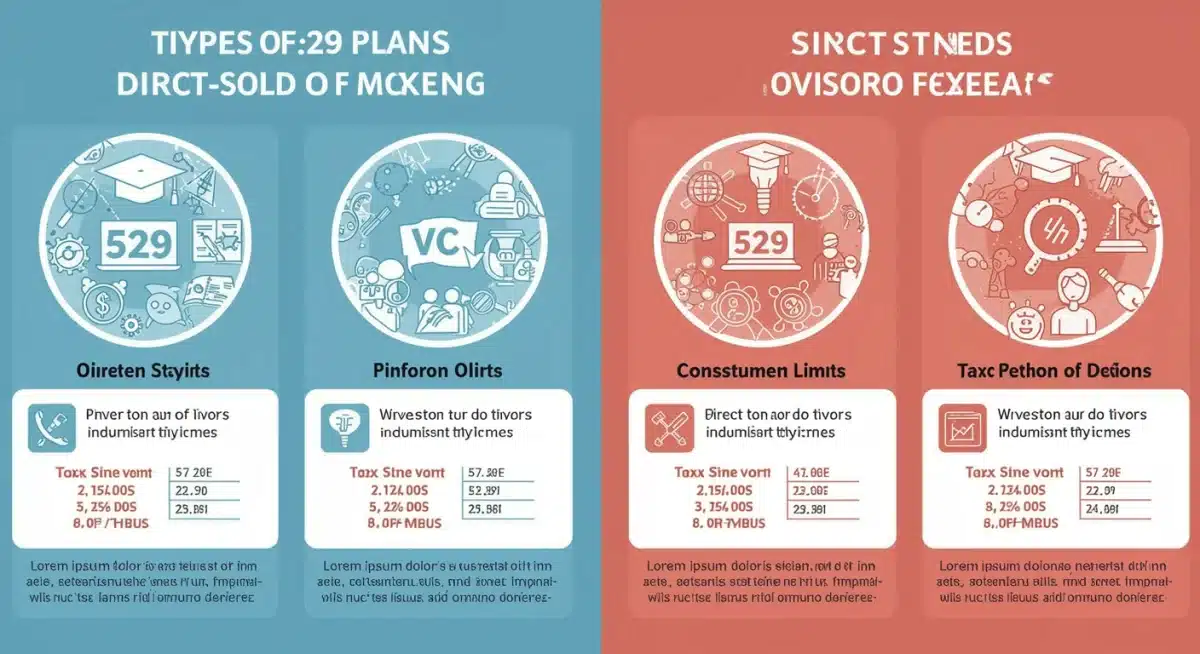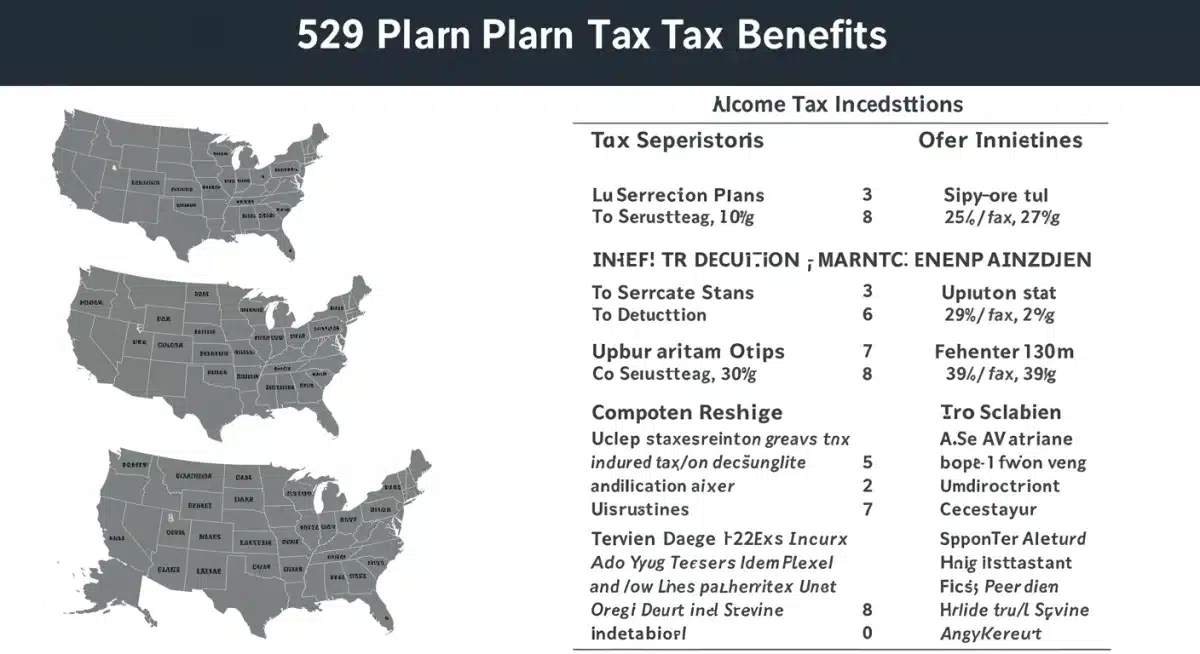529 Plans 2025: Best State Tax Advantages for US Families

Comparing 529 Plans in 2025 will reveal critical state-specific tax advantages and investment options that significantly impact college savings for US families, requiring careful analysis to maximize financial benefits.
Comparing 529 Plans in 2025: Which State’s Plan Offers the Best Tax Advantages for US Families? is a pressing question for millions of parents and guardians nationwide. As college costs continue to rise, leveraging every possible tax benefit becomes paramount. This analysis dives into the nuances of state-sponsored 529 plans, highlighting key features and financial implications families need to consider now to make informed decisions for future educational expenses.
Understanding the Basics of 529 Plans in 2025
529 plans are tax-advantaged savings plans designed to encourage saving for future education costs. Sponsored by states, state agencies, or educational institutions, these plans offer unique benefits that can significantly boost college savings. In 2025, the core appeal remains their federal tax-free growth and withdrawals for qualified education expenses, but state-level incentives introduce a complex layer of decision-making.
These plans come in two main types: college savings plans and prepaid tuition plans. College savings plans allow you to invest contributions in mutual funds, exchange-traded funds (ETFs), and other investment vehicles, with earnings growing tax-deferred. Prepaid tuition plans, less common, allow you to purchase future tuition credits at today’s prices, primarily for in-state public colleges.
Key Features of 529 College Savings Plans
- Tax-Free Growth: Investments grow free from federal income tax.
- Tax-Free Withdrawals: Qualified withdrawals for education expenses are also federal tax-free.
- State Tax Benefits: Many states offer deductions or credits for contributions.
- Beneficiary Control: The account owner retains control of the account, even after the beneficiary reaches adulthood.
Understanding these fundamental aspects is the first step in effectively comparing 529 plans. The federal tax benefits are universal, but the state tax advantages vary widely, making a thorough comparison essential for maximizing your savings.
Navigating State Income Tax Deductions and Credits
The most significant differentiator when comparing 529 plans across states often lies in their state income tax benefits. Many states offer residents a tax deduction or credit for contributions made to their own state’s 529 plan. Some states even extend these benefits to contributions made to out-of-state plans, though this is less common.
For example, states like New York and Pennsylvania offer generous deductions for contributions, which can translate into substantial annual tax savings for families. Conversely, states like California or Delaware offer no state income tax deduction or credit for 529 contributions, meaning residents in these states might benefit more from choosing a plan with lower fees or better investment options, regardless of its origin state.
States with Notable Tax Advantages for Residents
- Indiana: Offers a 20% tax credit on contributions up to $5,000, meaning a maximum credit of $1,000 per year.
- Kansas: Provides a deduction for contributions up to $3,000 per beneficiary per year (married filing jointly can deduct up to $6,000 per beneficiary).
- Maryland: Offers a deduction for contributions up to $2,500 per beneficiary per account holder per year.
- New York: Provides a deduction of up to $5,000 for single filers and $10,000 for married filing jointly.
It’s crucial to examine your own state’s specific rules, as these benefits can significantly offset the cost of saving. Families residing in states without such incentives have more flexibility to choose any 529 plan nationwide, prioritizing factors like investment performance and low fees.
Direct-Sold vs. Advisor-Sold 529 Plans: A Critical Choice
When you begin comparing 529 plans, you’ll generally encounter two main distribution channels: direct-sold and advisor-sold. The choice between these can impact fees, investment options, and the level of guidance you receive.
Direct-sold plans are typically purchased directly from the state or plan manager. They are often characterized by lower fees because they don’t involve a financial advisor’s commission. These plans are suitable for investors who are comfortable managing their own investments and selecting portfolios.

Advisor-sold plans, on the other hand, are purchased through a financial advisor. While they come with higher fees, including sales charges and ongoing advisor compensation, they offer professional guidance. An advisor can help tailor investment strategies to your financial goals and risk tolerance, and integrate the 529 plan into your broader financial planning. For families seeking personalized advice or those less confident in self-managing investments, an advisor-sold plan might be a worthwhile consideration, despite the higher costs.
Key Differences Between Direct-Sold and Advisor-Sold Plans
- Fees: Direct-sold plans generally have lower overall fees.
- Investment Guidance: Advisor-sold plans provide professional financial advice.
- Accessibility: Direct-sold plans are accessible online, while advisor-sold require a financial professional.
- Investment Options: Both can offer diverse investment portfolios, but the selection process differs.
Families must weigh the cost savings of direct-sold plans against the potential value of professional financial advice offered by advisor-sold options. This decision is a personal one, depending on your financial literacy, time availability, and comfort level with investment management.
Investment Options and Performance: Beyond Tax Benefits
While state tax advantages are a significant factor, the underlying investment options and their historical performance are equally critical when comparing 529 plans. Even the most generous state tax deduction can be negated by poor investment returns or high fees.
Most 529 plans offer a range of investment portfolios, often including age-based options, which automatically adjust their asset allocation to become more conservative as the beneficiary approaches college age. Other options might include static portfolios (fixed asset allocation), individual mutual funds, or even principal-protected options.
When evaluating investment options, consider the diversity of choices, the expense ratios of the underlying funds, and the overall historical performance of the portfolios offered. Websites like Morningstar provide extensive data and ratings for various 529 plans, offering valuable insights into their investment quality and costs. A well-performing plan, even one from an out-of-state provider that doesn’t offer your state’s tax deduction, could potentially yield greater net savings over the long term.
Factors to Evaluate in 529 Investment Options
- Expense Ratios: Lower fees mean more of your money working for you.
- Diversification: Ensure portfolios are well-diversified across asset classes.
- Age-Based Portfolios: Assess their glide path and underlying holdings.
- Past Performance: While not indicative of future results, it provides context.
The best 529 plan for your family will combine favorable tax benefits with robust investment options and reasonable fees. A holistic approach that considers all these elements is essential for maximizing your college savings.
The Impact of Reciprocity and Out-of-State Plans
Understanding reciprocity and the implications of investing in an out-of-state 529 plan is crucial for families. While many states offer tax incentives exclusively for contributions to their own 529 plans, a few states provide deductions or credits for contributions to any state’s 529 plan. This flexibility can open up a broader range of options for residents of these states.
For instance, Arizona, Missouri, and Pennsylvania are examples of states that offer tax parity, allowing residents to claim a state income tax deduction regardless of which state’s 529 plan they contribute to. This means a resident of Missouri could invest in, say, Utah’s highly-rated My529 plan and still receive a state income tax deduction from Missouri. This is a significant advantage, as it allows families to choose a plan based purely on its investment performance, fees, and overall quality, rather than being restricted by state-specific tax incentives.

For residents of states without tax parity, the decision becomes more complex. They must weigh the value of their home state’s tax deduction against the potential benefits of an out-of-state plan with superior investment options or lower fees. In some cases, the tax deduction might be substantial enough to make the in-state plan the most financially advantageous choice, even if its investment performance is not top-tier. In other scenarios, particularly for states with minimal or no tax benefits, opting for a highly-rated out-of-state plan could lead to greater long-term growth.
It is paramount for families to diligently compare the net financial impact, considering both state tax benefits and anticipated investment returns. This requires a careful calculation of potential tax savings versus potential additional investment gains from a different plan.
Key Considerations for US Families in 2025
Beyond tax advantages and investment performance, several other factors should influence your decision when comparing 529 plans in 2025. These include the plan’s fees, ease of use, customer service, and the flexibility of its withdrawal rules.
Fees can significantly erode your returns over time. These include administrative fees, underlying fund expense ratios, and potentially advisor fees. Always opt for plans with competitive fee structures. Ease of use, including online account access and contribution methods, can also enhance your experience. Good customer service is invaluable if you encounter questions or issues.
Additional Factors to Weigh in Your 529 Plan Selection
- Fees and Expenses: Scrutinize all layers of fees, including administrative, program management, and underlying fund fees.
- Contribution Flexibility: Look for plans that allow various contribution methods and frequencies.
- Withdrawal Rules: Ensure you understand what constitutes a qualified expense and any state-specific recapture rules for deductions or credits.
- Customer Service: Evaluate the responsiveness and helpfulness of the plan’s support channels.
Ultimately, the best 529 plan is one that aligns with your family’s financial situation, risk tolerance, and educational goals. A comprehensive review of all these elements will guide you toward an informed decision that maximizes your college savings potential.
Key Aspect |
Brief Description |
|---|---|
State Tax Benefits |
Deductions or credits for contributions, varying by state of residence and plan choice. |
Investment Options |
Range of portfolios, including age-based, with varying fees and historical returns. |
Direct vs. Advisor-Sold |
Choice impacts fees and access to professional financial guidance. |
Out-of-State Plans |
Consider for better performance/fees, especially if your state offers no tax parity. |
Frequently Asked Questions About 529 Plans
529 plans offer federal tax-free growth on investments and federal tax-free withdrawals for qualified education expenses. This means your earnings aren’t taxed as they grow, and you don’t pay federal income tax when you use the funds for college costs.
Yes, in some states. A few states offer tax parity, meaning they provide deductions or credits for contributions to any state’s 529 plan, not just their own. Always check your state’s specific rules to confirm eligibility.
Qualified expenses include tuition, fees, books, supplies, equipment, and room and board at eligible educational institutions. Computer technology and K-12 tuition up to $10,000 annually also count.
No, there are generally no federal income limitations for contributing to a 529 plan. However, there are typically high lifetime contribution limits per beneficiary, often exceeding $300,000, which vary by state.
Yes, you can change the beneficiary of a 529 plan to another eligible family member without tax consequences. This flexibility is a significant advantage if your initial beneficiary decides not to pursue higher education.
Looking Ahead: Maximizing Your College Savings Strategy
The landscape of 529 plans in 2025 presents both opportunities and complexities for US families. Understanding the intricate balance between state tax advantages, investment performance, and fee structures is crucial for making an optimal choice. As college costs continue their upward trajectory, proactive and informed decision-making regarding these savings vehicles will be a cornerstone of sound family financial planning. Families should regularly review their chosen plan and stay informed about any legislative changes that could impact their benefits.





